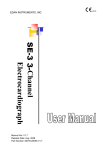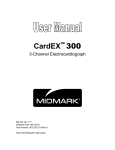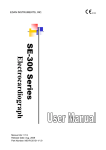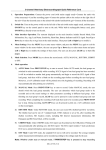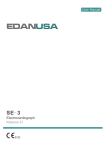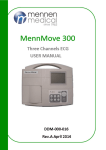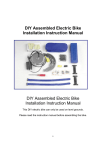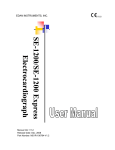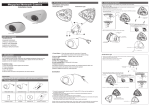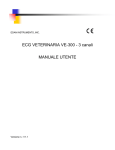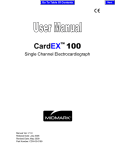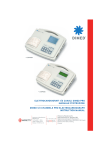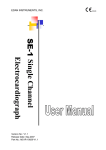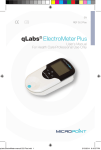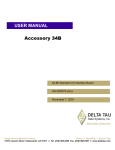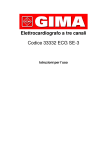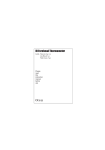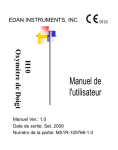Download Manual - Cardiac Direct
Transcript
EDAN INSTRUMENTS, INC. VE-300 Veterinary Electrocardiograph Manual Ver: V1.2 Release Date: March 2009 Part Number: MS1R-107182-V1.2 P/N:MS1R-107182-V1.2 Copyright © Copyright EDAN INSTRUMENTS, INC. 2008-2009. All rights reserved. Statement This manual will help you understand the operation and maintenance of the product better. It is reminded that the product shall be used strictly complying with this manual. User’s operation failing to comply with this manual may result in malfunction or accident for which Edan Instruments, Inc. (hereinafter called EDAN) can not be held liable. EDAN owns the copyrights of this manual. Without prior written consent of EDAN, any materials contained in this manual shall not be photocopied, reproduced or translated into other languages. Materials protected by the copyright law, including but not limited to confidential information such as technical information and patent information are contained in this manual, the user shall not disclose such information to any irrelevant third party. The user shall understand that nothing in this manual grants him, expressly or implicitly, any right or license to use any of the intellectual properties of EDAN. EDAN holds the rights to modify, update, and ultimately explain this manual. Responsibility of the Manufacturer EDAN only considers itself responsible for any effect on safety, reliability and performance of the equipment if: Assembly operations, extensions, re-adjustments, modifications or repairs are carried out by persons authorized by EDAN, and The electrical installation of the relevant room complies with national standards, and The instrument is used in accordance with the instructions for use. Upon request, EDAN may provide, with compensation, necessary circuit diagrams, and other information to help qualified technician to maintain and repair some parts, which EDAN may define as user serviceable. -I- Using This Label Guide This guide is designed to give key concepts on safety precautions. WARNING A WARNING label advises against certain actions or situations that could result in personal injury or death. CAUTION A CAUTION label advises against actions or situations that could damage equipment, produce inaccurate data, or invalidate a procedure. NOTE: A NOTE provides useful information regarding a function or a procedure. Revision History Date ECO# 2008.01 Version Description V1.0 1st edition 2nd edition 2008.08 ECO-QR-8029 V1.1 2009.03 ECO-SE-9005 V1.1 Added some information according to FDA -II- Table of Contents 1 Safety Guidance...................................................................................1 1.1 Intended use................................................................................................................. 1 1.2 Safety Warnings........................................................................................................... 1 1.3 Battery Care Warnings................................................................................................ 3 1.4 General Cautions......................................................................................................... 4 1.5 Cleaning & Disinfection Cautions.............................................................................. 5 2 Introduction..........................................................................................6 2.1 Function Features........................................................................................................ 6 2.2 List of Symbols............................................................................................................. 7 3 General Information...........................................................................10 3.1 Top Panel .................................................................................................................... 10 3.1.1 LCD Screen...................................................................................................... 10 3.1.2 Control Panel and Keys.................................................................................. 11 3.2 Patient Cable Socket and Signal Interface ............................................................ 14 3.3 Mains Connection and Switch ................................................................................. 17 3.4 Rear Panel .................................................................................................................. 17 3.5 Bottom Panel.............................................................................................................. 18 4 Operation Preparations .....................................................................21 4.1 Power and Earthing................................................................................................... 21 4.2 Loading/Replacing Record Paper ........................................................................... 22 4.3 Patient Cable Connection......................................................................................... 23 4.4 Electrode Connection................................................................................................ 24 4.5 Inspection before Power-On .................................................................................... 25 5 Operation Instructions ......................................................................27 5.1 Switching On .............................................................................................................. 27 5.2 AUTO Mode ................................................................................................................ 27 5.3 MANUAL Mode .......................................................................................................... 28 5.4 RHYTHM mode.......................................................................................................... 28 5.5 USBPRT mode........................................................................................................... 29 5.6 ECG Recall Operation .............................................................................................. 29 5.6.1 ECG Recall....................................................................................................... 29 5.6.2 ECG Copy ........................................................................................................ 32 5.7 Using the Menu System ........................................................................................... 33 5.7.1 Entering and Exiting the Menu ...................................................................... 33 5.7.2 Moving in the Sub-menus .............................................................................. 33 5.7.3 Parameter Modification .................................................................................. 33 5.8 Settings ....................................................................................................................... 33 5.8.1 Filter Settings ................................................................................................... 33 -III- 5.8.2 Record Settings ............................................................................................... 34 5.8.3 Record Output Settings .................................................................................. 35 5.8.4 Other Record Settings .................................................................................... 36 5.8.5 Save and Transmitting Settings .................................................................... 37 5.8.6 General Settings.............................................................................................. 38 5.8.7 System Settings............................................................................................... 39 5.8.8 Default Settings ............................................................................................... 40 5.9 AUTO mode record.................................................................................................... 42 5.10 RHYTHM mode record ........................................................................................... 44 5.11 USBPRT mode record ............................................................................................ 46 5.12 Switch Off.................................................................................................................. 47 6 Hint Information .................................................................................48 7 Technical Specifications ...................................................................49 8 Cleaning, Care and Maintenance......................................................52 8.1 Cleaning ...................................................................................................................... 52 8.1.1 Cleaning the Main Unit and Patient Cable .................................................. 52 8.1.2 Cleaning the Electrodes ................................................................................. 52 8.1.3 Cleaning the Print Head ................................................................................. 52 8.2 Disinfection ................................................................................................................. 53 8.3 Care and Maintenance ............................................................................................. 53 8.3.1 Recharge and Replacement of Battery........................................................ 53 8.3.2 Record Paper................................................................................................... 54 8.3.3 Maintenance of Main Unit, Patient Cable & Electrodes ............................ 54 9 Warranty and Service Policy.............................................................57 9.1 Warranty...................................................................................................................... 57 9.2 Service Policy............................................................................................................. 57 10 Accessories......................................................................................59 11 EMC Information - Guidance and Manufacture’s Declaration.......60 11.1 Electromagnetic Emissions - for all EQUIPMENT and SYSTEMS.................. 60 11.2 Electromagnetic Immunity - for all EQUIPMENT and SYSTEMS.................... 60 11.3 Electromagnetic Immunity - for EQUIPMENT and SYSTEMS that are not LIFE-SUPPORTING ........................................................................................................ 61 11.4 Recommended Separation Distances.................................................................. 63 -IV- VE-300 Veterinary Electrocardiograph User Manual 1 Safety Guidance In order to use the electrocardiograph safely and effectively, avoiding possible dangers caused by improper operations, please read through the user manual and be sure to be familiar with all functions of the equipment and proper operation procedures before use. Please pay more attention to the following warning and caution information. 1.1 Intended use The intended use of VE-300 Veterinary Electrocardiograph is to acquire ECG signals from animals through body surface with ECG electrodes. The VE-300 Veterinary Electrocardiograph is only intended to be used in animal hospitals or animal clinics by veterinarians. The cardiogram recorded by the electrocardiograph can help users to analyze and diagnose heart disease. 1.2 Safety Warnings WARNING : 1. The electrocardiograph is provided for the use of qualified physicians or personnel professionally trained. They should be familiar with the contents of this user manual before operation. 2. Only qualified service engineers can install this equipment, and only service engineers authorized by EDAN can open the shell. 3. Only qualified installation or service engineers can shift the mains shift switch (100V~115V/220V~240V) according to local mains supply. 4. The results given by the equipment should be examined with respect to the overall clinical condition of the animal, and it can not substitute for regular checking. WARNING : 5. EXPLOSION HAZARD-Do not use the electrocardiograph in the presence of flammable anesthetic mixture with oxygen or other flammable agents. 6. SHOCK HAZARD-The power receptacle must be a hospital grade grounded outlet. Never try to adapt the three-prong plug to fit a two-slot outlet. -1- VE-300 Veterinary Electrocardiograph User Manual 7. If the integrity of external protective conductor in installation or arrangement is in doubt, the equipment should be operated by using a built-in rechargeable battery. 8. Do not use this equipment in the presence of high static electricity or high voltage equipment which may generate sparks. 9. This equipment is not designed for direct cardiac application. WARNING : 10. Only patient cable and other accessories supplied by EDAN can be used. Or else, the performance and electric shock protection can not be guaranteed. 11. Be sure that all electrodes have been connected to the animal correctly before operation. 12. Ensure that the conductive parts of electrodes and associated connectors, including neutral electrode, do not come in contact with earth or any other conducting objects. 13. Electrodes with defibrillator protection should be used while defibrillating. 14. There is no danger for animals with pacemaker. However, if a pacemaker is used, the results given by the equipment may be invalid, or lose the clinical significance. 15. Do not touch the animal, bed, table and the equipment while using defibrillator or pacemaker simultaneously. 16. In order to avoid burning, please keep the electrode far away from the radio knife while using electrosurgical equipment simultaneously. 17. If you use electrode gel with reusable electrodes during defibrillation, the ECG recovery will be greater than 10 seconds. EDAN recommends the use of disposable electrodes at all times. WARNING : 18. Accessory equipment connected to the analog and digital interfaces must be certified according to the respective IEC/EN standards (e.g. IEC/EN 60950 for data processing equipment and IEC/EN 60601-1 for medical equipment). Furthermore all configurations shall comply with the valid version of the standard IEC/EN 60601-1-1. Therefore anybody, who connects additional equipment to the signal input connector or output connector to configure a -2- VE-300 Veterinary Electrocardiograph User Manual medical system, must make sure that it complies with the requirements of the valid version of the system standard IEC/EN 60601-1-1. If in doubt, consult our technical service department or your local distributor. 19. The summation of leakage current should never exceed leakage current limits while several other units are used at the same time. 20. The potential equalization conductor can be connected to that of other equipment when necessary, to make sure that all these equipment are connected with the potential equalization bus bar of the electrical installation. 1.3 Battery Care Warnings WARNING : 21. Improper operation may cause the battery to be hot, ignited or exploded, and it may lead to the declination of battery’s capacity. It is necessary to read the user manual carefully and pay more attention to warning messages. 22. Only qualified service engineer authorized by EDAN can open the battery compartment and replace the battery, and the battery of same model and specification provided by manufacturer should be used. 23. Danger of explosion -- Do not reverse the anode and cathode when connecting the battery. 24. Do not heat or splash the battery or throw it into fire or water. 25. When leakage or foul smell is found, stop using the battery immediately. If your skin or cloth comes into contact with the leakage liquid, cleanse it with clean water at once. If the leakage liquid splashes into your eyes, do not wipe them. Irrigate them with clean water first and go to see a doctor immediately. 26. When the battery’s useful life is over, contact with the manufacturer or local distributor for disposal or dispose the battery according to local regulations. 27. When the battery’s useful life is over, contact the manufacturer or local distributor for disposal or dispose the battery according to local regulations. -3- VE-300 Veterinary Electrocardiograph User Manual 1.4 General Cautions CAUTION 1. : Avoid liquid splash and excessive temperature. The temperature must be kept between 5℃ and 40℃ while working, and it should be kept between -20℃ and 55℃ during transportation & storage. 2. Do not use the equipment in dusty environment with bad ventilation or in the presence of corrosive. 3. Be sure that there is no intense electromagnetic interference source around the equipment, such as radio transmitter or mobile phone etc. Attention: large medical electrical equipment such as electrosurgical equipment, radiological equipment and magnetic resonance imaging equipment etc. are likely to bring electromagnetic interference. CAUTION 4. : Before use, the equipment, patient cable and electrodes etc. should be checked. Replacement should be taken if there is any evident defectiveness or aging symptom which may impair the safety or performance. 5. The following safety checks should be performed at least every 24 months by a qualified person who has adequate training, knowledge, and practical experience to perform these tests. a) Inspect the equipment and accessories for mechanical and functional damage. b) Inspect the safety relevant labels for legibility. c) Inspect the fuse to verify compliance with rated current and breaking characteristics. d) Verify the device functions properly as described in the instructions for use. e) Test the protection earth resistance according to IEC/EN 60601-1: Limit 0.2 ohm. f) Test the earth leakage current according to IEC/EN 60601-1: Limit: NC 500 uA, SFC 1000uA. g) Test the patient leakage current according to IEC/EN 60601-1: Limit: 10 uA (CF). -4- VE-300 Veterinary Electrocardiograph User Manual h) Test the patient leakage current under single fault condition with mains voltage on the applied part according to IEC/EN 60601-1: Limit: 50uA (CF). The data should be recorded in an equipment log. If the device is not functioning properly or fails any of the above tests, the device has to be repaired. 6. Ruptured fuse must only be replaced with that of the same type and rating as the original. 7. The device and accessories are to be disposed of according to local regulations after their useful lives. Alternatively, they can be returned to the dealer or the manufacturer for recycling or proper disposal. 8. Federal (US) law restricts this device to sale by or on the order of a veterinarian. 1.5 Cleaning & Disinfection Cautions CAUTION : 9. Turn off the power before cleaning and disinfection. If mains supply used, the power cord should be drugged out of the outlet also. Prevent the detergent from seeping into the equipment. 10. Do not immerse the unit or patient cable into liquid under any circumstances. 11. Do not clean the unit and accessories with abrasive fabric and avoid scratching the electrodes. 12. Any remainder of detergent should be removed from the unit and patient cable after cleaning. 13. Do not use chloric disinfectant such as chloride and sodium hypochlorite etc. -5- VE-300 Veterinary Electrocardiograph User Manual 2 Introduction VE-300 veterinary electrocardiograph is 3-channel electrocardiographs with 7 leads gathered simultaneously, visual display of operation menu, ECG parameters as well as electrocardiogram. 3-channel ECG can be viewed on the LCD (liquid crystal display) screen of veterinary electrocardiograph simultaneously, and it can be recorded by high-quality thermal recorder. Auto, manual, rhythm, USB print and off mode can be chosen freely. Either mains supply or built-in rechargeable Lithium battery can be used as power. With a high resolution thermal printer, a 32-bit processor and a huge capacity memorizer, VE-300 has advanced performance and high reliability, and the compact size makes it suitable for clinic and hospital use. Configuration: Main unit and accessories (power cord, earth wire, patient cable, electrodes and thermal record paper) WARNING : This equipment is not designed for direct cardiac application. WARNING : The results given by the equipment should be examined with respect to the overall clinical condition of the animal. And it can not substitute for regular checking. 2.1 Function Features ♦ Low weight and compact size ♦ Touch key for easy operation ♦ High resolution thermal recorder, recording frequency response ≤150Hz ♦ 7-lead sampled and amplified simultaneously, 3-channel built-in recorder ♦ Auto mode, manual mode, rhythm mode, USB print mode and off mode optional ♦ Auto measurement function ♦ Built-in rechargeable Li battery with high capacity ♦ Hint information for lead off, lack of paper and low battery capacity etc. -6- VE-300 Veterinary Electrocardiograph User Manual ♦ Automatic adjustment of baseline for optimal recording ♦ Standard input/output interface, RS232 communication interface and net port for linking to special network and setting up ECG database 2.2 List of Symbols External output External input Equipment or part of CF type with defibrillator proof Attention – general warning (see accompanying document) Potential equalization Mains supply On (mains supply) Off (mains supply) Battery indicator Battery recharging indicator Sensitivity switch key -7- VE-300 Veterinary Electrocardiograph User Manual Recall key 1mV calibration key& Copy key Mode/RST switch key Lead switch key Print/Stop key ON/OFF key Menu key Up Arrow/Down Arrow key Left Arrow/ Right Arrow key Recycle Part Number Serial Number -8- VE-300 Veterinary Electrocardiograph User Manual Date of Manufacture Manufacturer Authorized Representative in the European Community CE Mark The symbol indicates that the device should be sent to the special agencies according to local regulations for separate collection after its useful life and that this unit was put on the market after 13 August 2005. Rx only (U.S.) Federal (U.S.) Law restricts this device to sale by or on the order of a veterinarian. -9- VE-300 Veterinary Electrocardiograph User Manual 3 General Information 3.1 Top Panel Label LCD Screen Recorder Control Panel Figure 3-1 Main Unit Product Information: (Trade mark) VET ECG (Trade name) (Classification Symbol, equipment of CF type with defibrillator proof) 3.1.1 LCD Screen The LCD Screen specification: 192×64 dot single color LCD Screen. AUTO Paper? I II III 10mm/mV M ♥60 02Y Normally, the contents displayed on the LCD screen include: (descript from left to right) -10- VE-300 Veterinary Electrocardiograph User Manual First Row: ♦ Record mode(AUTO, MANUAL, RHYTHM, USBPRT or OFF) ♦ Hint information (Paper?, Printing, Sampling, Bat Weak etc.) ♦ Sex (M/F) and Age Second Row: ♦ Current lead (І, П, Ш, aVR, aVL, aVF, V) ♦ Sensitivity (×2.5mm/mV, ×5mm/mV, ×10mm/mV, ×20mm/mV, AGC) ♦ Heart rate ♦ Battery capacity(Only when the built-in battery is used) ( Actual heart rate) Third Row: ♦ ECG wave 3.1.2 Control Panel and Keys 1) Indicator Lamp Mains supply indicator lamp: when mains supply is used, the lamp will be lit. Battery indicator lamp: when the built-in rechargeable Lithium battery is used, the lamp will be lit. -11- VE-300 Veterinary Electrocardiograph User Manual Battery recharging indicator lamp: when the battery is recharged, this lamp will be lit. 2) SENS (Sensitivity Switch Key) The sensitivity switching order: ×10 mm/mV→×20 mm/mV → AGC→×2.5 mm/mV→ ×5 mm/mV. And AGC means auto gain control. 3) Recall Key Press this key to review the patient files saved in the recall window. 4) 1mV/COPY Key In the MANUAL mode, this key can be pressed to record a 1mV calibration pulse at any time while recording. In the AUTO mode, once a complete ECG was recorded, this key can be pressed to recall the electrocardiogram that recorded last time. 5) MODE/RST (Mode Switch Key) This key can be pressed to select record mode between AUTO, MANUAL, RHYTHM, USBPRT and OFF. The switching order of lead groups is listed in Table 3-1. Recording in the Manual mode, this key can be pressed to reset the waveform quickly. WARNING : When using the device with defibrillator, after the defibrillator discharge, the MODE/RST key should be pressed to reset the waveform quickly. -12- VE-300 Veterinary Electrocardiograph User Manual Table 3-1 Lead Group Switching Order of Different Mode Mode AUTO Switching Order (from left to right) Standard І/П/Ш aVR/aVL/aVF V Cabrera aVL/ I /-aVR II /aVF/ III V In this mode, need to press Lead Switch Key to change the lead , MANUAL the lead switch order can be that of AUTO(Standard) or AUTO(Cabrera), which is determined by settings of lead sequence and record format in the MENU 6) LEAD (Lead Switch Key) In the MANUAL mode, press the key to switch the lead group. In Recall window or Menu interface, this key can be pressed to turn the pages. 7) PRINT/STOP Key Used to begin recording and stop recording. 8) ON/OFF Key When the unit has been powered on, press this key to turn on it. Press again to turn off it. 9) MENU Key Press this key to enter menu settings. 10) Up Arrow/Down Arrow Pressing the Up Arrow or Down Arrow can select Sex or Age item on the main interface. -13- VE-300 Veterinary Electrocardiograph User Manual (hereinafter called Up/Down) During MENU setting, the two keys can also be pressed to select the item of which the setting is to be changed. 11) Left Arrow/ Right Arrow Press these keys to change the content of the selected item. During MENU setting, these keys can also be pressed to change the content of the selected item. (hereinafter called Left/Right) 3.2 Patient Cable Socket and Signal Interface There are sockets including the patient cable socket, RS232 socket, external input/output socket and USB interface at the right side of the main unit as following Figure shows. USB Interface Patient Cable Socket RS232 Socket External Input/Output Socket 1) Patient Cable Socket : Applied part of type CF with defibrillator proof : Attention – see accompanying document -14- VE-300 Veterinary Electrocardiograph User Manual Definition of corresponding pins: Signal Pin 1 NC 6 2 NC 3 Signal Pin Signal SH 11 F/LL (input) 7 NC 12 NC NC 8 NC 13 C /V(input) 4 NC 9 R /RA(input) 14 NC 5 NC 10 L /LA(input) 15 N or RF /RL(input) Note: The left side of “/” is European standard; and the right side is American standard. 2) RS232 Socket WARNING : RS232 interface is 1500V AC isolated intensity and the maximum voltage applied should not exceed +15V DC. Definition of corresponding pins: Pin Signal Pin Signal Pin Signal 1 NC 4 NC 7 NC 2 RxD (input) 5 GND 8 NC 3 TxD (output) 6 NC 9 NC 3) External Input/Output Socket -15- VE-300 Veterinary Electrocardiograph User Manual Definition of corresponding pins: Pin Signal Pin Signal 1 GND 4 GND 2 GND 5 ECG Signal (input) 3 GND 6 ECG Signal (output) 4) USB Interface Definition of corresponding pins: Pin Signal Pin 1 VBUS 3 D+ 2 D- 4 GND WARNING Signal : Only the USB equipments recommended by EDAN can be connected to the USB interface. WARNING ♦ : Accessory equipment connected to the analog and digital interfaces must be certified according to the respective IEC/EN standards (e.g. IEC/EN60950 for data processing equipment and IEC/EN 60601-1 for medical equipment). Furthermore all configurations shall comply with the valid version of the standard IEC/EN 60601-1-1. Therefore anybody, who connects additional equipment to the signal input or output connector to configure a medical system, must make sure that it complies with the requirements of the valid version of the system standard IEC/EN 60601-1-1. If in doubt, consult our technical service department or your local distributor. ♦ The summation of leakage current should never exceed leakage current limits while several other units are used at the same time. -16- VE-300 Veterinary Electrocardiograph User Manual 3.3 Mains Connection and Switch Potential equalization terminal Mains Power Switch Mains Supply Socket 1) Potential Equalization Terminal Potential equalization conductor provides a connection between the unit and the potential equalization bus bar of the electrical installation. 2) Mains Supply Socket AC SOURCE: alternating current supply socket 3) Power Switch : Switch on : Switch off 3.4 Rear Panel Net Port -17- VE-300 Veterinary Electrocardiograph User Manual 3.5 Bottom Panel Mains Supply Shift Switch Battery Compartment Fuse Fuse Label Label -18- VE-300 Veterinary Electrocardiograph User Manual 1) Battery Compartment The battery label indicates the rated voltage and rated capacity of rechargeable Lithium battery pack. Rated voltage: 14.8V, Rated capacity: 2000mAh /2200mAh /2400mAh. Attention – general warning (see accompanying document) WARNING : Improper operation may cause the battery to be hot, ignited or exploded, and it may lead to the decrease of battery’s capacity. Therefore, it is necessary to read the user manual carefully and pay more attention to warning messages. WARNING : When leakage or foul smell found, stop using the battery immediately. If the leakage liquid gets to your skin or cloth, cleanse it with clean water at once. If the leakage liquid gets into your eyes, do not wipe them. Irrigate them with clean water first and go to see a doctor immediately. WARNING : Only qualified service engineer authorized by EDAN can open the battery compartment and replace the battery, and the battery of same model and specification provided by manufacturer must be used. 2) Mains Supply Shift Switch Mains supply with rated input voltage 230V (220V~240V) or 115V (100V~115V) can be chosen by the shift switch according to local mains supply specification. WARNING : Only qualified installation or service engineers can shift the mains shift switch according to local mains supply. 3) Fuse There are two same fuses installed on the bottom of the main unit. The specification is showed on the fuse label: AC220V-240V: T200mA; AC100V-115V: T400mA; Φ5×20. -19- VE-300 Veterinary Electrocardiograph User Manual WARNING : Ruptured fuse must only be replaced with that of the same type and rating as the original. -20- VE-300 Veterinary Electrocardiograph User Manual 4 Operation Preparations CAUTION : Before use, the equipment, patient cable and electrodes should be checked. Replace it if there is any evident defectiveness or aging which may impair the safety or performance, and be sure that the equipment is in proper working condition. 4.1 Power and Earthing WARNING : If the integrity of external protective conductor in installation or arrangement is in doubt, the equipment should be operated from the built-in rechargeable battery. Power Supply The electrocardiograph can be powered either by mains supply or the built-in rechargeable lithium battery pack. ♦ Mains supply The mains connection socket is on the left of the unit. If mains supply is used, connect the power cord to the socket first, and then connect the plug of the cord to the hospital grade outlet. Rated input voltage: 100V~115V or 220V~240V Rated frequency: 50Hz/60Hz Rated input power: 35VA Make sure the mains supply meets the above requirements before power on, and then press the mains power switch to power on the unit. Then the mains supply indicator lamp ( ) will be lit. If the built-in rechargeable battery is weak when mains supply used, it will be recharged automatically at the same time. And both the mains supply indicator lamp ( ) and the battery recharging indicator lamp ( ) will be lit. ♦ Built-in rechargeable battery While using the built-in rechargeable lithium battery pack, turn on the unit by pressing ON/OFF key on control panel directly and the battery indicator lamp ( The battery symbol ) will be lit. will be displayed on the LCD screen. Because of the -21- VE-300 Veterinary Electrocardiograph User Manual consumption during storage and transport, the capacity of battery may not be full. If the and the hint information “BAT WEAK” are displayed, which means the symbol battery capacity is weak, please recharge the battery first. Please refer to the maintenance section for how to recharge the battery. During recharging the battery, VE-300 can be powered by mains supply. WARNING : Potential equalization conductor of the unit should be connected to the potential equalization bus bar of the electrical installation when necessary. 4.2 Loading/Replacing Record Paper Two kinds of paper can be used as ECG record paper. One is Rolled thermal paper with 80mm width, and the other is folded thermal paper with 80mm width. Note: When using folded thermal paper, the Paper Roller is unnecessary, and it can be taken out. When there is no record paper loaded or it reaches the end of record paper, warning message “Paper?” will be given on the screen. Under this circumstance, record paper should be loaded or replaced immediately. Casing Paper Tray Paper Roller Thermal Print Head Printer Platen Groove Loading/Replacing Process for Rolled thermal paper: 1) Place fingers under the flange of the recorder casing, pull upwards directly to release the casing; 2) Take out the paper roller, and remove remain paper from the left of roller if necessary; -22- VE-300 Veterinary Electrocardiograph User Manual 3) Take off the wrapper of thermal paper roll, and then put through the roller from the left with the paper’s grid side facing downward; 4) Place the paper and roller gently in the recorder with the roller pin on the roller’s left side facing to the groove; 5) Pull about 2cm of paper out, and put down the recorder casing; 6) Secure the casing by pressing it firmly. Loading/Replacing Process for Folded thermal paper: 1) Place fingers under the flange of the recorder casing, pull upwards directly to release the casing; 2) Remove residual paper in the Paper Tray if necessary; 3) Take off the wrapper of folded thermal paper, and then put it in the Paper Tray with the paper’s grid side facing the thermal print head while put the free end of paper upright; 4) Pull about 2cm of paper out, and put down the recorder casing; 5) Secure the casing by pressing it firmly. 4.3 Patient Cable Connection WARNING : The performance and electric shock protection can be guaranteed only if original EDAN patient cable and electrodes are used. Patient cable includes two parts, main cable and lead wires with associated electrode connectors. The electrode connectors can be distinguished from the color and identifier on them. Lead Wires Main Cable Electrode Connectors Connector Electrodes Connecting Main Cable: Plug the connector of main cable into the patient cable socket on the right side of the unit, and secure the screw. -23- VE-300 Veterinary Electrocardiograph User Manual 4.4 Electrode Connection Clamp The identifier and color code of electrode connectors used complies with IEC/EN requirements. In order to avoid incorrect connections, the electrode identifier and color code are specified in Table 4-1. Moreover the equivalent code according to American requirements is given too. Table 4-1 Electrodes and Identifiers and Color Codes European Electrodes Identifier American Color code Identifier Color code Right fore limb R Red RA White Left fore limb L Yellow LA Black Right rear limb N or RF Black RL Green Left rear limb F Green LL Red Chest C White V Brown As the following figure shows, the electrodes’ positions on body surface are European Standard Dog American Standard Cat Dog Cat The contacting resistance between the animal and the electrode will affect the quality of ECG greatly. In order to get a high-quality ECG, the skin/electrode resistance must be minimized while connecting electrodes. -24- VE-300 Veterinary Electrocardiograph User Manual Electrodes connection: 1) Ensure that the electrodes are clean; 2) Align lead wires of patient cable to avoid twisting; 3) Clean electrode area on a short distance with alcohol; 4) Daub the electrode area with gel evenly; 5) Place a small amount of gel on the metal part of electrode clamp; 6) Clamp the electrode to the electrode area. Attach all electrodes in the same way. WARNING : Be sure that all electrodes have been connected to the animal correctly before operation. WARNING : Be sure that the conductive parts of electrodes and associated connectors, including neutral electrode, should not contact with earth or any other conducting objects. 4.5 Inspection before Power-On In order to avoid safety hazards and get good ECG records, the following inspection procedure is recommended before power-on and operation. 1) Environment: ♦ Check and make sure that there is no electromagnetic interference source around the equipment, especially large medical electrical equipment such as electrosurgical equipment, radiological equipment and magnetic resonance imaging equipment etc. Switch off these devices when necessary. ♦ Keep the examination room warm to avoid muscle action voltages in ECG signal caused by cold. 2) Power Supply: ♦ If mains power is used, please check whether the power cord has been connected to the unit well, and the grounded three-phase outlet should be used. ♦ 3) Recharge the battery first when the battery capacity is weak before use. Patient Cable: ♦ Check whether the patient cable has been connected to the unit firmly, and keep it far away from the power cord. -25- VE-300 Veterinary Electrocardiograph User Manual 4) Electrodes: ♦ Be sure that all electrodes have been connected to the animal correctly. ♦ Ensure that the electrodes do not contacted with each other. 5) Recorder Paper: ♦ Ensure that there is enough recorder paper loaded correctly. 6) Animal: ♦ The animal should not contact conducting objects such as earth, and metal part of bed etc. ♦ Ensure the animal is warm and relaxed, and breathe calmly. WARNING : The electrocardiograph is provided for the use of qualified physicians or personnel professionally trained, and they should be familiar with the contents of this user manual before operation. -26- VE-300 Veterinary Electrocardiograph User Manual 5 Operation Instructions 5.1 Switching On ♦ While using mains supply, press the power switch on the left side of the unit first, and the mains supply indicator lamp ( ) is lit. Then press ON/OFF key on the control panel to turn on the unit. Equipment information such as device name and version No. will be displayed on LCD screen after self-test. Then VE-300 is ready for examination and recording. ♦ While using built-in rechargeable lithium battery, press ON/OFF key on the control panel directly to turn on the unit, and then the battery indicator ( ) is lit. After self-test, VE-300 is ready for examination and recording. 5.2 AUTO Mode In the AUTO mode, the lead groups are switched in order automatically while recording. When ECG signal of one lead group has been recorded, it will be switched to another lead group automatically and begin recording the ECG signal of that lead group. And there is a blank on the recording paper before recording the next ECG signal. Moreover, a 1mV calibration mark will be recorded at the beginning of recording. The lead group switching orders are listed in Table 3-1. Operation Method: 1) Press MODE/RST key to choose AUTO mode, which will be displayed in the top left corner on LCD screen; 2) Press MENU key to enter the Menu window to set the record settings. Press it again to return after setup; 3) Press PRINT/STOP key to begin recording. It will stop automatically after recording a full ECG. Pressing PRINT/STOP again during the course of recording can stop recording. However, when begin recording later, ECG will be recorded from the first lead group again. And ID number will change automatically according to the current time. If the ID number needs to be unchanged, the user should adjust it before recording. Note: Whether in auto or manual mode, recording mode can not be changed during the course of recording. Stop recording before choose recording mode. -27- VE-300 Veterinary Electrocardiograph User Manual Note: In the OFF mode, the sampled ECG waves will not be recorded. The average template and/or measurement information can be recorded according to the settings made by the user. 5.3 MANUAL Mode In the MANUAL mode, users should switch the lead group manually. Users can determine which lead group needs to be recorded and set the record settings or other parameters according to different lead group. Operation Method: 1) Press MODE/RST key to choose MANUAL mode, which can be discerned by the identifier in the top left corner of LCD screen; 2) Press MENU key to enter the Menu window to set the record settings. Press it again to return after setup; 3) Press LEAD left arrow or right arrow key to select leads to be recorded; 4) Press PRINT/STOP key to begin recording; 5) 1mV/COPY key can be pressed to print out 1mV mark while ECG recording; 6) Press PRINT/STOP key to stop recording after finishing ECG record. LEAD left and right arrow key can be pressed to switch the lead group during the course of recording. Pressing PRINT/STOP again during the course of recording can stop recording. However, when begin to record later, ID number will change automatically according to the current time. If the ID number needs to be unchanged, the user should adjust it before recording. 5.4 RHYTHM mode In the Rhythm mode, the user can record 60s rhythm-lead ECG waveform. 1) Press MENU key to enter the Menu window to set the RHYTHM LEAD or other settings. Press it again to return after setup; 2) Press MODE/RST key to choose RHYTHM mode; 3) Press PRINT/STOP key and the hint information “Sampling” will be displayed in the hint information field. When the sampling time reaches 60s, it begins to record; 4) It will stop automatically after recording a full rhythm-lead ECG waveform. Pressing PRINT/STOP again during the course of recording can stop recording. -28- VE-300 Veterinary Electrocardiograph User Manual 5.5 USBPRT mode In the USBPRT mode, ECG report can be printed out through USB printer. 1) Connect VE-300 to the USB printer recommended by EDAN; 2) Press MENU key to enter Menu window to set corresponding options. Press it again to return after setup; 3) Press MODE/RST key to choose USBPRT mode; 4) Press PRINT/STOP key to begin recording. It will stop automatically after recording a full ECG report. 5.6 ECG Recall Operation 5.6.1 ECG Recall Press RECALL key to enter the recall window where patient files are saved. The recall window allows files to be stored, deleted, printed and transmitted. When there is no space for more files to be stored in the recall window, the message “Mem Full” is displayed on the main interface. 0506080950 Recall Window (a) 0506080956 0506080957 TRANS ALL DEL ALL USB to ECG DELETE RECORD 0506080950 Recall Window (b) 0506080956 0506080957 TRANSMIT Recall Window (c) 0506080950 0506080956 0506080957 ALL to USB -29- To USB VE-300 Veterinary Electrocardiograph User Manual Operation for ECG RECALL: 1) Press RECALL key to enter the Recall Window (a) where patient files are saved; 2) If the user wants to transmit all the files, press Left or Right to choose TRANS ALL, and then press PRINT/STOP or MENU key to transmit all the files; If the “Auto Transfer” option is not selected before transmitting, WARNING (a) will pop up to remind the user to do it first. WARNING (a) ERROR Please Select “Auto Transfer” Option first! Press PRINT/STOP return [PRINT]- >OK Note: Before transmitting patient files, please set the AUTO TRANSFER option in Menu window. Refer to 5.8.5 Transfer Settings for detail. 3) If the user wants to delete all the files, press Left or Right to choose DEL ALL, and then press PRINT/STOP or MENU key to pop up the WARNING(b). Then press RECALL to delete all the files or PRINT/STOP to cancel deleting; WARNING (b) WARNING WARNNING You will delete all the files! Are you sure? _________________________________ [RECALL]- >OK [PRINT]- >CANCEL 4) If the user wants to import files (The extended-name should be “.dat”) from the ECGDATA folder of the U disk to the electrocardiograph, press Left or Right to choose USB to ECG, and then press PRINT/STOP or MENU key to begin to import; Note: To import files in U disk to electrocardiograph, there should be some files in the folder named ECGDATA in the U disk. The folder name “ECGDATA” must be capital letters. And the user should not change the name of files in the ECGDATA folder. During the course of USB to ECG, if something wrong happens, the electrocardiograph will give the error information. And then the user should do the following operations: Firstly, check whether the U disk is connected well, and correct it. If the error information is still displayed, the user should check whether some files exist in the ECGDATA folder of the U disk. If nothing is found, the user should build a folder named ECGDATA in the U disk and put some files (The extended-name is “.dat”) into the ECGDATA folder. -30- VE-300 Veterinary Electrocardiograph User Manual If the error information is still displayed, then the user should check whether the total number of files in the ECGDATA folder of the U disk and in the recall window of the electrocardiograph has exceeded the limit (The limit of VE-300 is 120). If the total number has exceeded the limit, the user should remove some files from the ECGDATA folder of the U disk and then continue to import. If the error information is still displayed, then the user should check whether there are some files in the U disk having the same name with the files in the electrocardiograph. If it is true, the user should remove these files from the U disk, or delete these files in the electrocardiograph, and then continue to import. (Under this situation, this error information is “The same file found! Press PRINT/STOP return”.) After finishing importing files, the electrocardiograph will give a distinct indication. Note: Only FAT format should be selected when formatting the U disk. If the user wants to copy all the files from the electrocardiograph to the U disk, press Left or Right to choose ALL to USB, and then press PRINT/STOP or MENU key to begin to copy; after a while, all the files will be copied into the ECGDATA folder of the U disk automatically. During the course of ALL to USB, if something wrong happens, the electrocardiograph will give the error information. And then the user should check whether the U disk is connected well, and correct it. Note: The process of TRANS ALL, USB to ECG or ALL to USB needs long time to be finished, and the user should be patient to wait. During the course of copying, the U disk should not be pulled out. 5) Press Up or Down to choose one of the files in the recall window; If the user wants to transmit this file, press Left or Right to choose TRANSMIT button, and then press PRINT/STOP or MENU key to transmit the file; If the “Auto Transfer” option is not selected before transmitting, WARNING (a) will pop up to remind the user to do it first. If the user wants to delete this file, Press Left or Right to choose DELETE button, and then press PRINT/STOP or MENU key to pop up the WARNING(c). Then press RECALL to delete this file or PRINT/STOP to cancel deleting; -31- VE-300 Veterinary Electrocardiograph User Manual WARNING WARNNING WARNING (c) You will delete this file! Are you sure? _________________________________ [RECALL]- >OK [PRINT]- >CANCEL If the user wants to record this file, press Left or Right to choose RECORD button, and then press PRINT/STOP or MENU key to begin recording; Pressing PRINT/STOP again during the course of recording can stop recording. Note: If the user selects USBPRT mode to print, when PRINT/STOP key or MENU key is pressed, the electrocardiograph begins to analyze data, and after 8 seconds the USB printer begins to print. Note: MANUAL or RHYTHM mode can not support recall printing. If the user selects MANUAL or RHYTHM mode to record, WARNING (d) will pop up. WARNING (d) ERROR MANUAL or RHYTHM mode can not recall printing, Press PRINT/STOP return YES If the user wants to copy this file to the U disk, press Left or Right to choose To USB, and then press PRINT/STOP or MENU key to begin to copy; 6) Press RECALL key to return to the main interface. Note: To save the ECG data to the recall window as patient files, please refer to 5.8.5 Save Option Settings. 5.6.2 ECG Copy In the auto mode, once a complete ECG was recorded, pressing 1mV/Copy key can recall the electrocardiogram that was recorded last time. Pressing PRINT/STOP during the course of recording can stop recording. Note: After recording is finished, if RECORD FORMAT or SAMPLE MODE is changed, ECG Copy is not permitted. -32- VE-300 Veterinary Electrocardiograph User Manual 5.7 Using the Menu System 5.7.1 Entering and Exiting the Menu Press the MENU key to enter the menu, and press the MENU key again to exit the menu. AC Filter EMG Filter DFT Filter Lowpass Filter : On : Off : 0.15Hz : 100Hz 5.7.2 Moving in the Sub-menus Press Up or Down to choose the setting items; 5.7.3 Parameter Modification Press Left or Right to modify a parameter; Note: When modifying Record Mode or Sensitivity on the main interface, to save the modifications, the user should enter the menu interface and exit. After that, the user will see the modifications on the main interface when he turns on the electrocardiograph again. 5.8 Settings 5.8.1 Filter Settings AC Filter EMG Filter DFT Filter Lowpass Filter : On : Off : 0.15Hz : 100Hz Four filters can be set in the MENU window. They are: AC FILTER, EMG FILTER, DFT FILTER and LOWPASS FILTER. AC FILTER AC FILTER suppresses AC interference without attenuating or distorting the ECG. Select On -33- VE-300 Veterinary Electrocardiograph User Manual to turn on the function and select Off to turn off. EMG FILTER EMG FILTER suppresses disturbances caused by strong muscle tremor. The cutoff frequency is user-defined at 25Hz, 35Hz or 45Hz. Select Off to turn off the function. DFT FILTER DFT FILTER greatly reduces the baseline fluctuations without affecting the ECG signal. The purpose of this filter is to keep the ECG signals on the baseline of the printout. The setting value is the low limit of the frequency range, including 0.05Hz, 0.15Hz, 0.25Hz, 0.5Hz, and is normally set to 0.15Hz. LOWPASS FILTER LOWPASS FILTER restricts the bandwidth of input signal. The cutoff frequency is user defined at 150Hz, 100Hz or 75Hz. All the input signals whose frequency is higher than the setting cutoff frequency will be attenuated. 5.8.2 Record Settings Record Format Record Grid Record Speed Record Length : 3Ch : Off : 25mm/s : Short RECORD FORMAT When RECORD FORMAT is 3Ch, limb leads will be recorded in 2 groups of 3. When RECORD FORMAT is 3Ch+1R, limb leads will be recorded in 2 groups of 3, with one rhythm lead at the bottom of recording paper. When RECORD FORMAT is 1Ch, all leads will be recorded one by one in a sequence. When RECORD FORMAT is 1Ch+1R, all leads will be recorded one by one in a sequence, with one rhythm lead at the bottom of recoding paper. RECORD GRID When RECORD GRID is On, the dashed grids which are 5 mm by 5 mm will be recorded on the paper. When RECORD GRID is Off, dashed grids will not be recorded on the paper. -34- VE-300 Veterinary Electrocardiograph User Manual RECORD SPEED In the MANUAL/RHYTHM mode, RECORD SPEED can be set as 5, 6.25, 10, 12.5, 25 or 50mm/s. In the AUTO/OFF/USBPRT mode, RECORD SPEED can be set as 25 or 50mm/s. RECORD LENGTH Short form means that each lead group will be recorded about 2.5 seconds. Medium form means that each lead group will be recorded about 5 seconds. Long form means that each lead group will be recorded about 7.5 seconds. Longest form means that each lead group will be recorded about 10 seconds. Note: When RECORD FORMAT is 1Ch, only Short form is supported in RECORD LENGTH. 5.8.3 Record Output Settings Average Template Measurement Interpretation RR Analysis : 2Ch+1R : Off : Off : On AVERAGE TEMPLT When AVERAGE TEMPLT is 2Ch+1R, limb leads will be recorded in 3 groups of 2, with one rhythm lead at the bottom of recoding paper. When AVERAGE TEMPLT is 3Ch, limb leads will be recorded in 2 groups of 3. When AVERAGE TEMPLT is Off, there will be no average template when recording. RR ANALYSIS When RR ANALYSIS is On, RR Analysis results, including RR Interval measurement information, RR Histogram and RR Trend Chart, will be recorded after rhythm wave is recorded in the RHYTHM mode. When RR ANALYSIS is Off, there will be no RR Analysis results after rhythm wave is recorded in the RHYTHM mode. -35- VE-300 Veterinary Electrocardiograph User Manual MEASUREMENT When MEASUREMENT is On, the measure information will be recorded when recording in AUTO mode. When MEASUREMENT is Off, there will be no measure information when recording. Note: To get the content of MEASUREMENT, please refer to Chapter 5.9 ECG Record. Note: The function of Interpretation is not supported in this version. 5.8.4 Other Record Settings Lead Sequence Sample Mode Rhythm Lead Paper Style : Standard : All CH Simu. : II : Rolled LEAD SEQUENCE: Standard/Cabrera Lead Sequence Lead group 1 Lead group 2 Standard І, II, Ш aVR, aVL, aVF V Cabrera aVL, І, -aVR II, aVF, Ш V Lead group 3 SAMPLE MODE 1CH Sequent. Lead is sampled one by one in a certain sequence. 3CH Sequent. Lead group is sampled one by one in a certain sequence. All CH Simu. All leads are sampled simultaneously. RHYTHM LEAD The rhythm lead can be one of 7 standard leads: І, П, Ш, aVR, aVL, aVF and V. -36- VE-300 Veterinary Electrocardiograph User Manual PAPER STYLE Rolled thermal paper and folded thermal paper can be selected as record Paper. Note: If the user sets the PAPER STYLE as Folded paper, after ECG recording is completed in Auto mode or RHYTHM mode, recording will stop when a black sign is detected, or it will stop with hint information “Paper Err” when no black sign is detected. 5.8.5 Save and Transmitting Settings Save Option : Off Auto Transfer : Off Local IP : 192. 168. 001. 021 Remote IP : 192. 168. 001. 245 SAVE OPTION When SAVE OPTION is On, the ECG data will be saved into the recall window automatically while it is being recorded in AUTO recording mode. When SAVE OPTION is Off, the ECG data will not be saved into the recall window while it is being recorded in AUTO recording mode. Note: When there is no space for more files to be stored in the recall window, the message ”Mem Full” is displayed on the main interface. AUTO TRANSFER Note: To transfer ECG data to PC, Smart ECG-Viewer software of EDAN must be installed in PC. Receive ECG Data window in the software should be opened up, transfer type should be selected, and other settings should be finished. When AUTO TRANSFER is OFF, the patient files can not be transferred; When AUTO TRANSFER is UART AUTO, firstly connect the serial port of PC and the RS232 socket of veterinary electrocardiograph with serial cable recommended by the manufacturer. Then open the Receive ECG Data window of Smart ECG-Viewer software in PC, select the transfer type “Serial Trans”, set the right PortNum and press Connect button. In the AUTO mode or OFF mode, ECG data can be transferred through UART port automatically after ECG recording is finished. When AUTO TRANSFER is Net AUTO, firstly connect the net interface of PC and the net interface of veterinary electrocardiograph with Ethernet cable recommended by the manufacturer. Secondly open the Receive ECG Data window of Smart ECG-Viewer software -37- VE-300 Veterinary Electrocardiograph User Manual in PC, select the transfer type “Net Trans” and press Connect button. Then set the REMOTE IP and LOCAL IP in Menu window in veterinary electrocardiograph. In the AUTO mode or OFF mode, ECG data can be transferred through net automatically after ECG recording is finished. Note: During the course of transferring or saving data, if the power supply is suddenly cut off, File System error may arise in the electrocardiograph. After the error is displayed, the user should format the File System. REMOTE IP IP address of the remote computer which receives ECG data from electrocardiograph through net LOCAL IP IP address of electrocardiograph 5.8.6 General Settings Key Beep QRS Beep Extern Inp/Outp Record Test : On : Off : Off : Off KEY BEEP When KEY BEEP is On, a short beep sound will be made when press the control key. When KEY BEEP is Off, there is no sound while pressing the key. QRS BEEP During the course of ECG recording, if QRS BEEP is On, the unit will make a short beep sound when an R wave has been detected. So in normal recording, continuous and regular sound of beep will be heard. EXTERN INP/OUTP External input/output signal interface is equipped in VE-300, through which VE-300 can receive ECG signal from external equipment, or output ECG signal to other external equipment. Set this item as On to turn on the function and Off to turn off. RECORD TEST -38- VE-300 Veterinary Electrocardiograph User Manual Press Left or Right to start record test when the record paper has been loaded. Then the triangle wave in effective paper width will be recorded. The status of print head can be estimated from this triangle wave. Press Left or Right again to stop record test. 5.8.7 System Settings Demo Setting Language Setting Lead Setting Default Setting : Off : English : 7 Leads : Restore DEMO SETTING: Select On to enter the Demo mode. LANGUAGE SETTING: The user can set the system language. LEAD SETTING: The user can set the lead number as 7 or 6. When 6 Leads is selected, the leads include I, II, III, aVR, aVL and aVF. DEFAULT SETTING: Select Restore to resume default setting value. Note: In the Parameter Options Column, some parameters’ options have no underline, which means these parameters have no default settings. And when the user restores default settings, these parameters will not change. Date Mode 18-01-2008 ID Password : dd-mm-yyyy 11:30 : 0801180723 :000000 DATE MODE: Date mode can be set as dd-mm-yyyy, mm-dd-yyyy or yyyy-mm-dd. After set, the current date format will change according to the DATE MODE you selected. DATE&TIME SETTING: Set current Date and time. It will be recorded on the record paper. ID: Animal ID number PASSWORD: Password for entering the advanced control interface -39- VE-300 Veterinary Electrocardiograph User Manual 5.8.8 Default Settings In the following table, the value double-underlined is default setting. No. Items Options 1 AC Filter On, Off 2 EMG Filter Off, 25Hz, 35Hz, 45Hz 3 DFT Filter 0.05Hz, 0.15Hz, 0.25Hz, 0.5Hz 4 Lowpass Filter 75Hz, 100Hz, 150Hz 5 Record Format 3Ch, 3Ch+1R, 1Ch, 1Ch+1R 6 Record Grid Off, On 7 Record Speed 5mm/s, 6.25mm/s, 10mm/s, 12.5mm/s, 25mm/s, 50mm/s 8 Record Length Short, Medium, Long, Longest 9 Average Template 2Ch+1R, Off, 3Ch 10 Measurement Off, On 11 Interpretation Off 12 RR Analysis On, Off 13 Lead Sequence Standard, Cabrera 14 Sample Mode All CH Simu., 3CH Sequent., 1CH Sequent. 15 Rhythm Lead I, II, III, aVR, aVL, aVF, V 16 Paper Style Rolled, Folded 17 Save Option Off, On 18 Auto Transfer Off, UART AUTO, Net AUTO 19 Local IP 192. 168. 001. 021 20 Remote IP 192. 168. 001. 245 21 Key Beep On, Off 22 QRS Beep Off, On 23 Extern Inp/Outp Off, On -40- VE-300 Veterinary Electrocardiograph User Manual 24 Record Test Off, Testing 25 Demo Setting Off, On 26 Language Setting Chinese, English 27 Lead Setting 7 leads, 6 leads 28 Default Setting Restore 29 Data Mode dd-mm-yyyy, mm-dd-yyyy, yyyy-mm-dd 30 Date Setting 24-12-2007 31 Time Setting 08 : 23 32 ID 071224-0823 33 Password Password for entering the advanced control interface -41- VE-300 Veterinary Electrocardiograph User Manual 5.9 AUTO mode record (a) (b) Figure (a) shows the following content: 10mm/mV----Sensitivity 0.15~100Hz----Filter information AC50----50Hz AC Filter 08-01-2008 09:49:15----Date and time ----1mV calibration mark I, II, III, aVR, aVL, aVF, V----Lead name ECG wave of 7 leads in the format of 3Ch 25mm/s----Paper speed -42- VE-300 Veterinary Electrocardiograph User Manual VE-300 V1.0----Model of the equipment and version number Figure (b) shows the AVERAGE TEMPLET (2Ch+1R) and the MEASUREMENT (ON). And the items of the MEASUREMENT include: ID, Owner, Name, Type, Age, Sex, BP, Weight, HR (Heart Rate) P Dur----P wave duration: mean of duration of P-wave from several of 12 selected dominant beats; PR int----P-R interval: mean of P-R interval from several of 12 selected dominant beats; QRS Dur----QRS complex duration: mean of duration of QRS complexes from several of 12 selected dominant beats; QT/QTC int----Q-T interval: mean of Q-T interval from several of 12 selected dominant beats/Normalized QT interval; P/QRS/T axis----dominant direction of the average integrated ECG vectors; Note: Recording in the AUTO mode or MANUAL mode, if the Sensitivity is set as 20mm/mV, only one calibration mark will be displayed on the paper. -43- VE-300 Veterinary Electrocardiograph User Manual 5.10 RHYTHM mode record (a) (b) Figure (a) shows the following content: 10mm/mV (Sensitivity) 0.15~100Hz (Filter information) AC50 (50Hz AC Filter) 08-01-2008 09:51:19----Date and time (1mV calibration mark) -44- VE-300 Veterinary Electrocardiograph User Manual II (Lead name) 60 seconds rhythm waveform of lead II 00:00, 00:20, 00:40 (Timer) 60 (Heart rate) 25mm/s (Paper speed) Figure (b) shows RR Analysis Results, including RR Interval measurement information, RR Histogram and RR Trend Chart. RR Interval measurement information includes the following content: Current Date & Current Time Animal Information (ID, Owner, Name, Type, Age, Sex, BP, Weight) Measure Time Total R Num (Total R-wave number) HR (Heart Rate) RR Avg Interval (Average RR interval) RR Max Interval (Maximum RR interval) RR Min Interval (Minimum RR interval) SDNN (Standard Deviation of Normal to Normal Intervals) RMSSD (The Root Mean Square of Successive Difference) -45- VE-300 Veterinary Electrocardiograph User Manual 5.11 USBPRT mode record -46- VE-300 Veterinary Electrocardiograph User Manual As figure above shows, the USBPRT mode record includes: ID, Record speed, Hint information, Sensitivity, Date and time; Owner, Name, Type, Age, Sex, BP, Weight; Heart Rate, P duration, PR interval, QRS duration, QT/QTC interval, P/QRS/T axis; Minnesota code; (Written by doctor) Diagnosis information; (Written by doctor) Report confirmed by; (Written by doctor) ECG waveform of 7 leads; 5.12 Switch Off When built-in battery pack used, press ON/OFF key directly to turn off the unit after finishing ECG record. When mains supply used, press ON/OFF key first after finishing ECG record and then switch off the mains supply by pressing the switch on the left side of the unit. Pull off the plug from the outlet last. Note: When switching off the device, please operate it according to the sequence above strictly, or else there will be something wrong on the screen. -47- VE-300 Veterinary Electrocardiograph User Manual 6 Hint Information Hint information will be displayed when there is something wrong. Hint information provided by VE-300 and corresponding cause is listed in Table 6-1. Table 6-1 Hint Information and Causes Hint Information Causes Lead off Electrodes fall off from the animal or the patient cable falls off from the unit. BAT WEAK The built-in battery is weak. Paper? Record paper has not been loaded or it has been run out. PaperErr Feed paper error. Sampling/Printing ECG signal is being sampled / Printed. Modu Err There is something wrong with the signal sample module. Demo The system is in demonstration mode. Process The ECG data is being processed. Transfer The patient file is being transferred through UART port or Ethernet. Mem Full There is no space for more files to be saved. Overload The direct current voltage on an electrode is too high. Uprinter An USB printer is connected to the USB interface. USBExist An U disk is connected to the USB interface. -48- VE-300 Veterinary Electrocardiograph User Manual 7 Technical Specifications Safety IEC 60601-1:1988+A1+A2, EN 60601-1:1990+A1+A2, Standards IEC/EN 60601-1-2:2001+A1, IEC/EN 60601-2-25, ANSI/AAMI EC-11 Classification Anti-electric-shock type: Class І with internal power supply Anti-electric-shock degree: Type CF Degree of protection against harmful ingress of water: Ordinary equipment (Sealed equipment without liquid proof) Disinfection/sterilization method: Refer to the user manual for details Degree of safety of application in the presence of flammable gas: Equipment not suitable for use in the presence of flammable gas Working mode: Continuous operation EMC: Group І, type A Dimensions 288mm×210mm×70mm Weight About 2.5kg Display 192×64 dot single color LCD Screen Environment Transport/Storage Working Temperature: -20℃~55℃ 5℃~40℃ Relative 25%~93% 25%~80% non-condensing non-condensing 700hPa ~1060hPa 860hPa ~1060hPa Humidity: Atmospheric Pressure: Power Supply Rated input voltage =100V~115V/220V~240V Mains Supply: Rated frequency = 50/60Hz Rated input power = 35VA Built-in Lithium Battery Rated voltage = 14.8V Pack: Rated capacity = 2000mAh /2200mAh /2400mAh Charge mode: Constant current/voltage Charge current (standard) = 0.2C5A (320mA) -49- VE-300 Veterinary Electrocardiograph User Manual Charge voltage (standard) = (17±0.1V) Cycle life ≥ 300 times Recording Power Consumption: 35VA (max) Fuse: T400mA250V Ø5×20/T200mA 250V Ø5×20 Recorder: Thermal dot-matrix printer Folded thermal paper, 80mm width Record Paper: Rolled thermal paper, 80mm width Effective Width: Paper Speed: HR Recognition ECG Unit 72mm 5mm/s, 6.25mm/s, 10mm/s, 12.5mm/s, 25mm/s, 50mm/s(±3%) Accuracy of data: ±5% (x-axis), ±5%(y-axis) Technique: Peak-peak detection HR Range: 30 BPM ~300 BPM Accuracy: ±1BPM Leads: 7 standard leads Acquisition Mode: simultaneously 7 leads A/D Resolution: 12 bits Time Constant: ≥3.2s Frequency Response: 0.05Hz ~ 150Hz(-3dB) Sensitivity: 2.5, 5, 10, 20 (mm/mV) Input Impedance: 50M Ω (10Hz) Input Circuit Current: ≤50nA Input Voltage Range: <±5 mVpp Calibration Voltage: 1mV±3% DC Offset Voltage: ±500mV Noise: <12.5 µ Vp-p Multichannel crosstalk: ≤0.5mm Filter: AC Filter: On/Off -50- VE-300 Veterinary Electrocardiograph User Manual DFT Filter: 0.05/0.15/0.25/0.5 EMG Filter: 25Hz/35Hz/45Hz/OFF LOWPASS Filter:150Hz/100Hz/75Hz CMRR: ≥110dB Sampling Frequency: 1000Hz Patient Leakage Current: <10 µ A (220V~240V) Patient Auxiliary Current: <0.1 µ A (DC) Dielectric Strength: 4000V rms External Input/Output Input: ≥100k Ω ; Sensitivity 10mm/V±5%; Single ended (Optional) Output: ≤100 Ω ; Sensitivity 1V/mV±5%; Single ended -51- VE-300 Veterinary Electrocardiograph User Manual 8 Cleaning, Care and Maintenance 8.1 Cleaning CAUTION : Turn off the power before cleaning and disinfection. Mains supply must be switch off if it has been in use. 8.1.1 Cleaning the Main Unit and Patient Cable The surfaces of the main unit and patient cable can be wiped with a clean soft cloth damped in soapy water or non-caustic neutral detergent. After that, remove detergent remainder with a clean dry cloth. 8.1.2 Cleaning the Electrodes Remove the remainder gel from the electrodes with a clean soft cloth first. Clean them in warm water and be sure there is no remainder gel. Dry the electrodes with a clean dry cloth or air dry naturally. 8.1.3 Cleaning the Print Head Dirty and soiled thermal print head will deteriorate the record definition. So it should be cleaned at least once a month regularly. Open the recorder casing and remove the paper. Wipe the print head gently with a clean soft cloth damped in 75% alcohol. For stubborn stain, soak it with a little alcohol first and wipe it off with a clean soft cloth. After air dried, load the record paper and shut the casing of the recorder. CAUTION : Prevent the detergent from seeping into the main unit while cleaning. Do not immerse the unit or patient cable into liquid under any circumstances. CAUTION : Do not clean the unit and accessories with abrasive fabric and avoid scratching the electrodes. -52- VE-300 Veterinary Electrocardiograph User Manual 8.2 Disinfection To avoid permanent damage to the equipment, disinfection can be performed only when it has been considered as necessary according to your hospital’s regulations. Before disinfection clean the equipment first. Then wipe the surfaces of the unit and patient cable with hospital standard disinfectant. CAUTION : Do not use chloric disinfectant such as chloride and sodium hypochlorite etc. 8.3 Care and Maintenance 8.3.1 Recharge and Replacement of Battery 1) Capacity Identification Current capacity of the rechargeable battery can be identified according to the battery symbol on the main interface. : Full capacity : Capacity is limited, and recharge should be taken into account : Battery is weak; and warning message “BAT WEAK” will be displayed on LCD screen. The battery should be recharged immediately 2) Recharge VE-300 is equipped with recharge control circuit together with built-in rechargeable lithium battery. When connect with the mains supply, the battery will be recharged automatically. And then the battery recharge indicator lamp ( ) and the mains supply indicator lamp ( will be lit at the same time. During the course of recharging, the symbol “ the main interface. When the capacity of battery is full, the symbol “ and the battery recharge indicator lamp ( ) ” will flash on ” will stop flashing, ) will usually be black. But if VE-300 is power off, the lamp will still lit just because the equipment will not monitor the recharge status; so you need to power on the device to verify the status. Because of the capacity consumption during storage and transport, the capacity of battery is not full while using at the first time. Battery recharge should be considered before first -53- VE-300 Veterinary Electrocardiograph User Manual usage. Note: If the battery has not been used for two or three months above, recharge should be done before use the battery again. 3) Replacement When the useful life of battery is over, or foul smell and leakage has been found, please contact with manufacturer or local distributor for replacement of battery. WARNING ♦ : Only qualified service engineer authorized by EDAN can open the battery compartment and replace the battery. And the battery of same model and specification provided by manufacturer must be used. ♦ Danger of explosion -- Do not reverse the anode and cathode when connecting the battery. ♦ When the battery’s useful life is over, contact with the manufacturer or local distributor for disposal or dispose the battery according to local regulations. 8.3.2 Record Paper Note: Record paper provided by manufacturer should be used. Other paper may shorten thermal print head’s life. And the deteriorated print head may lead to illegible ECG record and block the advance of paper etc. Storage requirements: ♦ Record paper should be stored in dry, dark and cool area, avoiding excessive temperature, humidity and sunshine. ♦ Do not put the paper under fluorescence for long time. ♦ Be sure that there is no polyvinyl chloride or other chemicals in the storage environment, which will lead to color change of the paper. ♦ Do not overlap the recorded paper long time, or else the ECG record may trans-print each other. 8.3.3 Maintenance of Main Unit, Patient Cable & Electrodes The following safety checks should be performed at least every 24 months by a qualified person who has adequate training, knowledge, and practical experience to perform these tests. -54- VE-300 Veterinary Electrocardiograph User Manual a) Inspect the equipment and accessories for mechanical and functional damage. b) Inspect the safety related labels for legibility. c) Inspect the fuse to verify compliance with rated current and breaking characteristics. d) Verify the device functions properly as described in the instructions for use. e) Test the protection earth resistance according to IEC/EN 60601-1: Limit 0.2ohm. f) Test the earth leakage current according to IEC/EN 60601-1: Limit: NC 500uA, SFC 1000uA. g) Test the patient leakage current according to IEC/EN 60601-1: Limit: 10uA (CF). h) Test the patient leakage current under single fault condition with mains voltage on the applied part according to IEC/EN 60601-1: Limit: 50uA (CF). The leakage current should never exceed the limit. The data should be recorded in an equipment log. If the device is not functioning properly or fails any of the above tests, the device has to be repaired. WARNING : Failure on the part of the responsible individual hospital or institution employing the use of this equipment to implement a satisfactory maintenance schedule may cause undue equipment failure and possible health hazards. 1) Main Unit ♦ Avoid excessive temperature, sunshine, humidity and dirt. ♦ Put on the dustproof coat after use and prevent from shaking violently when moving it to another place. ♦ Prevent any liquid from seeping into the equipment, for it will affect the safety and performance of electrocardiograph. 2) Patient Cable ♦ Integrity of patient cable, including main cable and lead wires, should be checked regularly. And be sure that it is conductible. ♦ Do not drag or twist the patient cable with excessive stress while using. Hold the connector plugs instead of the cable when connecting or disconnecting the patient cable. ♦ Align the patient cable to avoid twisting, knotting or crooking in closed angle while using. ♦ Store the lead wires in a bigger wheel to prevent any people from stumbling. ♦ Once damage or aging of the cable patient has been found, replace it with a new one -55- VE-300 Veterinary Electrocardiograph User Manual immediately. 3) Electrodes ♦ Electrodes must be cleansed after use and be sure there is no remainder gel on them. ♦ After long-term use, the surface of electrodes will be oxidized because of erosion and other causes. By this time, electrodes should be replaced to achieve high-quality ECG. CAUTION : The device and accessories are to be disposed of according to local regulations after their useful lives. Alternatively, they can be returned to the dealer or the manufacturer for recycling or proper disposal. -56- VE-300 Veterinary Electrocardiograph User Manual 9 Warranty and Service Policy 9.1 Warranty EDAN warrants that EDAN’s products meet the labeled specifications of the products and are free from defects in materials and workmanship that occur within warranty period. The warranty period begins on the date the products are shipped to distributors. The warranty is void in the cases of: a) damage caused by handling during shipping. b) subsequent damage caused by improper use or maintenance. c) damage caused by alteration or repair by anyone not authorized by EDAN. d) damage caused by accidents. e) replacement or removal of serial number label and manufacture label. If a product covered by this warranty is found to be defective because of defective materials, components, or workmanship, and the warranty claim is made within the warranty period, EDAN will, at its discretion, repair or replace the defective part(s) free of charge. EDAN will not provide a substitute product for use when the defective product is being repaired. 9.2 Service Policy All repairs on products must be performed or approved by EDAN. Unauthorized repairs will void the warranty. In addition, whether covered under warranty or not, any product repair shall be exclusively be performed by EDAN certified service personnel. If the product fails to function properly-or if you need assistance, service, or spare parts-contact EDAN’s service center. A representative will assist you troubleshooting the problem and will make every effort to solve it over the phone or by email, avoiding potential unnecessary returns. In case a return can not be avoided, the representative will record all necessary information and will provide a Return Material Authorization (RMA) form that includes the appropriate return address and instructions. An RMA form must be obtained prior to any return. Freight policy: -57- VE-300 Veterinary Electrocardiograph User Manual Under warranty: the service claimer is responsible for freight & insurance charges when a return is shipped to EDAN for service including custom charges. EDAN is responsible for freight, insurance & custom charges from EDAN to service claimer. Out of warranty: the service claimer is responsible for any freight, insurance & custom charges for product. Contact information: If you have any question about maintenance, technical specifications or malfunctions of devices, contact your local distributor. Alternatively, you can send email to EDAN service department at: [email protected] -58- VE-300 Veterinary Electrocardiograph User Manual 10 Accessories WARNING : Only patient cable and other accessories supplied by EDAN can be used. Or else, the performance and electric shock protection can not be guaranteed. Table 10-1 Accessories List No. 1 Accessory Manufacturer / Part Number Power cord EDAN / M13R-36014 LAUNCH / MS1R-109826-A0 (European standard) 2 Patient cable LAUNCH / MS1R-109827-A0 (American standard) 3 Alligator clip electrode LAUNCH / M15R-040144 4 Paper roller EDAN / MS1-19993 5 Thermal paper EDAN / M50R-78076 The following accessories can also be ordered according to some special usage. No. Accessory Manufacturer / Part No. 1 Earth wire EDAN / MS1-20016 2 Input/output signal cable EDAN / MS1-19907 3 Flat clip electrode LAUNCH / M15R-040145 4 Carrying Bag EDAN / MS1-107119-A0 VE-300 and accessories are available by contacting the manufacturer or your local distributor. Manufacturer: EDAN INSTRUMENTS, INC. Address: 3/F - B, Nanshan Medical Equipments Park, Nanhai Rd 1019#, shekou, Nanshan Shenzhen, 518067 P.R. China Zip code: 518067 Tel: +86-755-26882220 Fax: +86-755-26882223 -59- VE-300 Veterinary Electrocardiograph User Manual 11 EMC Information - Guidance and Manufacture’s Declaration 11.1 Electromagnetic Emissions - for all EQUIPMENT and SYSTEMS Guidance and manufacture’s declaration – electromagnetic emission The VE-300 Veterinary Electrocardiograph is intended for use in the electromagnetic environment specified below. The user of the VE-300 Veterinary Electrocardiograph should assure that it is used in such an environment. Emission test Electromagnetic environment – guidance Compliance RF emissions The VE-300 Veterinary Electrocardiograph uses RF CISPR 11 energy only for its internal function. Therefore, its Group 1 RF emissions are very low and are not likely to cause any interference in nearby electronic equipment. RF emission Class A CISPR 11 The VE-300 Veterinary Electrocardiograph is suitable for use in all establishments other than domestic Harmonic emissions Class A IEC 61000-3-2 and those directly connected to the public low-voltage power supply network that supplies Voltage fluctuations/ building used for domestic purposes. flicker emissions Complies IEC 61000-3-3 11.2 Electromagnetic Immunity - for all EQUIPMENT and SYSTEMS Guidance and manufacture’s declaration – electromagnetic immunity The VE-300 Veterinary Electrocardiograph is intended for use in the electromagnetic environment specified below. The user of VE-300 Veterinary Electrocardiograph should assure that it is used in such an environment. Immunity test IEC 60601 test level Compliance level Electromagnetic environment - guidance Electrostatic ±6 kV contact ±4 kV contact It is recommended the use of discharge (ESD) ±8 kV air ±8 kV air antistatic materials. If floor are IEC 61000-4-2 covered with synthetic material, -60- VE-300 Veterinary Electrocardiograph User Manual the relative humidity should be at least 50%. Electrical fast ±2 kV for power supply ±1 kV for power supply It is recommended the use of transient/burst lines lines filters on power input lines and enough separation between IEC61000-4-4 signal lines and power lines. Surge ±1 kV differential ±1 kV differential mode Mains power quality should be IEC 61000-4-5 mode ±2 kV common mode that of a typical commercial or ±2 kV common mode hospital environment. Voltage dips, <5% UT <5% UT Mains power quality should be short (>95% dip in UT) (>95% dip in UT) that of a typical commercial or interruptions and for 0.5 cycle for 0.5 cycle hospital environment. on power supply 40% UT 40% UT input lines (60% dip in UT) (60% dip in UT) IEC 61000-4-11 for 5 cycles for 5 cycles 70% UT 70% UT (30% dip in UT) (30% dip in UT) for 25 cycles for 25 cycles <5% UT <5% UT (>95% dip in UT) (>95% dip in UT) for 5 sec for 5 sec 3A/m 3A/m voltage variations Power frequency Power frequency magnetic fields (50Hz) magnetic should be at levels characteristic field of a typical location in a typical IEC 61000-4-8 commercial or hospital environment. NOTE UT is the a.c. mains voltage prior to application of the test level. 11.3 Electromagnetic Immunity - for EQUIPMENT and SYSTEMS that are not LIFE-SUPPORTING Guidance and manufacture’s declaration – electromagnetic immunity The VE-300 Veterinary Electrocardiograph is intended for use in the electromagnetic environment specified below. The customer or the user of VE-300 Veterinary Electrocardiograph should assure that it is used in such an environment. Immunity test IEC 60601 test level Compliance level Electromagnetic environment - guidance Portable and mobile RF communications equipment should be used no closer to any part of the VE-300 -61- VE-300 Veterinary Electrocardiograph User Manual Veterinary Electrocardiograph, including cables, than the recommended separation distance calculated from the equation applicable to the frequency of the transmitter. Recommended separation distance Conducted RF 3 Vrms IEC 61000-4-6 150 kHz to 80 MHz Radiated RF 3 V/m IEC61000-4-3 80 MHz to 2.5 GHz 3 Vrms 3.5 d = P V1 3 V/m 3.5 d = P E1 80 MHz to 800 MHz 7 d = P E1 800 MHz to 2.5 GHz Where P is the maximum output power rating of the transmitter in watts (W) according to the transmitter manufacturer and d is the recommended separation distance in metres (m). Field strengths from fixed RF transmitters, as a determined by an electromagnetic site survey, should be less than the compliance level in each frequency b range. Interference may occur in the vicinity of equipment marked with the following symbol: NOTE 1 At 80 MHz and 800 MHz, the higher frequency range applies. NOTE 2 These guidelines may not apply in all situations. Electromagnetic propagation is affected by absorption and reflection from structures, objects and people. a Field strengths from fixed transmitters, such as base stations for radio (cellular/cordless) telephones and land mobile radios, amateur radio, AM and FM radio broadcast and TV broadcast cannot be predicted theoretically with accuracy. To assess the electromagnetic environment due to fixed RF transmitters, an electromagnetic site survey should be considered. If the measured field strength in the location in which the Electrocardiograph is used exceeds the applicable RF compliance level above, the Electrocardiograph should be observed to verify normal operation. If abnormal performance is observed, additional measures may be necessary, such as reorienting or relocating the Electrocardiograph. b Over the frequency range 150 kHz to 80 MHz, field strengths should be less than 3 V/m. -62- VE-300 Veterinary Electrocardiograph User Manual 11.4 Recommended Separation Distances Recommended separation distances between portable and mobile RF communications equipment and electrocardiograph The VE-300 Veterinary Electrocardiograph is intended for use in an electromagnetic environment in which radiated RF disturbances are controlled. The customer or the user of the VE-300 Veterinary Electrocardiograph can help prevent electromagnetic interference by maintaining a minimum distance between portable and mobile RF communications equipment (transmitters) and the VE-300 Veterinary Electrocardiograph as recommended below, according to the maximum output power of the communications equipment. Separation distance according to frequency of transmitter Rated maximum (m) output power of 150 kHz to 80 MHz 80 MHz to 800 MHz 800 MHz to 2.5 GHz transmitter (W) 3.5 d = P V1 3.5 d = P E1 7 d = P E1 0.01 0.12 0.12 0.23 0.1 0.38 0.38 0.73 1 1.2 1.2 2.3 10 3.8 3.8 7.3 100 12 12 23 For transmitters rated at a maximum output power not listed above, the recommended separation distance d in meters (m) can be estimated using the equation applicable to the frequency of the transmitter, where P is the maximum output power rating of the transmitter in watts (W) according to the transmitter manufacturer. NOTE 1 At 80 MHz and 800 MHz, the separation distance for the higher frequency range applies. NOTE 2 These guidelines may not apply in all situations. Electromagnetic propagation is affected by absorption and reflection from structures, objects and people. -63- EDAN INSTRUMENTS, INC. 3/F - B, Nanshan Medical Equipments Park, Nanhai Rd 1019#, shekou, Nanshan Shenzhen, 518067 P.R. China TEL:86-755-26882220 FAX: +86-755-26882223 EC REPRESENTATIVE Shanghai International Holding Corp. GmbH (Europe) Eiffestrasse 80, D-20537 Hamburg Germany TEL: +49-40-2513175 FAX: +49-40-255726 E-mail: [email protected]





































































